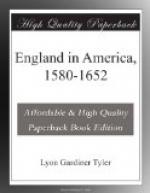Suddenly, about the middle of the century, English commerce struck out boldly; conscious rivalry with Spain had begun. The new era opens fitly with the return of Sebastian Cabot to England from Spain, where since the death of Henry vii. he had served Charles V. In 1549, during the third year of Edward vi., he was made grand pilot of England with an annual stipend of L166 13s. 4d.[11] He formed a company for the discovery of the northeast and the northwest passages, and in 1553 an expedition under Sir Hugh Willoughby and Richard Chancellor penetrated the White Sea and made known the wonders of the Russian Empire.[12] The company obtained, in 1554, a charter of incorporation under the title of the “Merchant Adventurers for the Discovery of Lands, Territories, Isles, Dominions, and Seignories Unknown or Frequented by Any English.” To Russia frequent voyages were thereafter made. A few days after the departure of Willoughby’s expedition Richard Eden published his Treatyse of the Newe India; and two years later appeared his Decades of the New World, a book which was very popular among all classes of people in England. Cabot died not many years later, and Eden, translator and compiler, attended at his bedside, and “beckons us with something of awe to see him die."[13]
During Mary’s reign (1553-1558) the Catholic church was restored in England, and by the influence of the queen, who was married to King Philip, the expanding commerce of England was directed away from the Spanish colonial possessions eastward to Russia, Barbary, Turkey, and Persia. After her death the barriers against free commerce were thrown down. With the incoming of Elizabeth, the Protestant church was re-established and the Protestant refugees returned from the continent; and three years after her succession occurred the first of those great voyages which exposed the weakness of Spain by showing that her rich possessions in America were practically unguarded and unprotected.
In 1562 Sir John Hawkins, following in the track of his father William Hawkins, visited Guinea, and, having loaded his ship with negroes, carried them to Hispaniola, where, despite the Spanish law restricting the trade to the mother-country, he sold his slaves to the planters, and returned to England with a rich freight of ginger, hides, and pearls. In 1564 Hawkins repeated the experiment with greater success; and on his way home, in 1565, he stopped in Florida and relieved the struggling French colony of Laudonniere, planted there by Admiral Coligny the year before, and barbarously destroyed by the Spaniards soon after Hawkins’s departure.[14] The difference between our age and Queen Elizabeth’s is illustrated by the fact that Hawkins, instead of being put to death as a pirate for engaging in the slave-trade, was rewarded by the queen on his return with a patent for a coat of arms.




